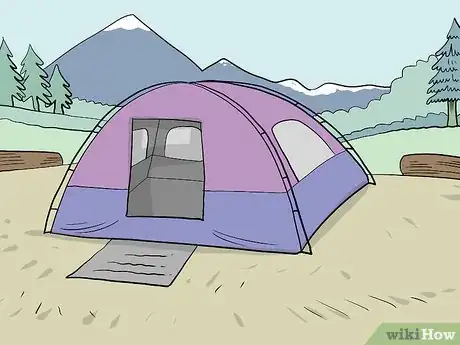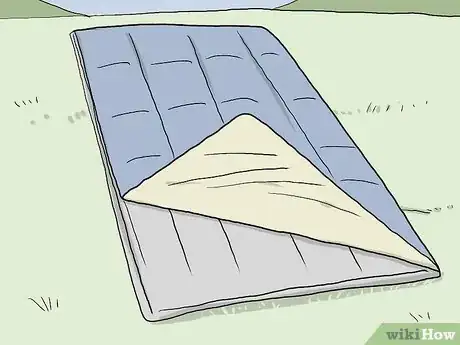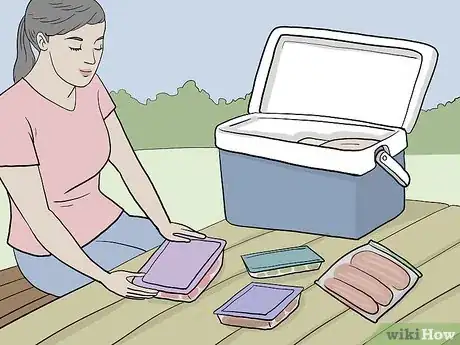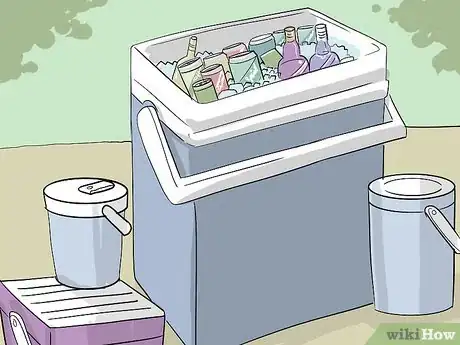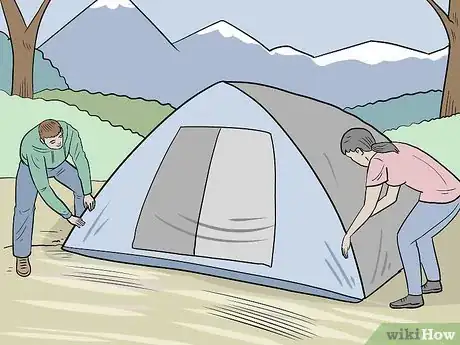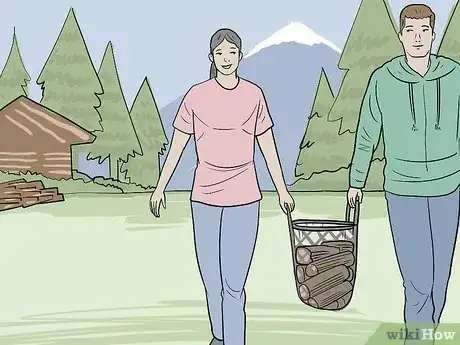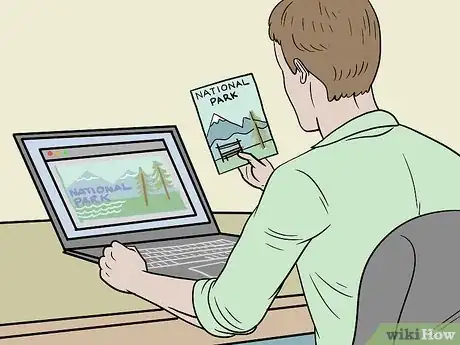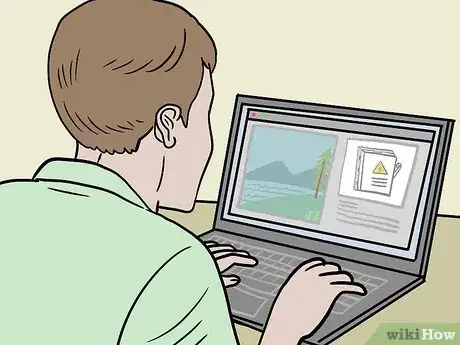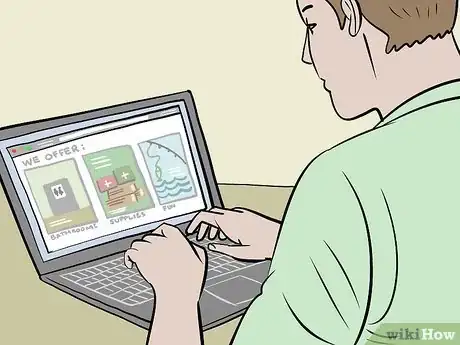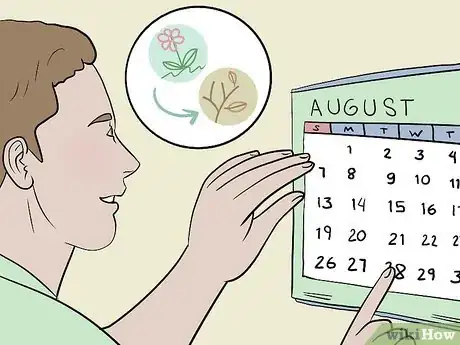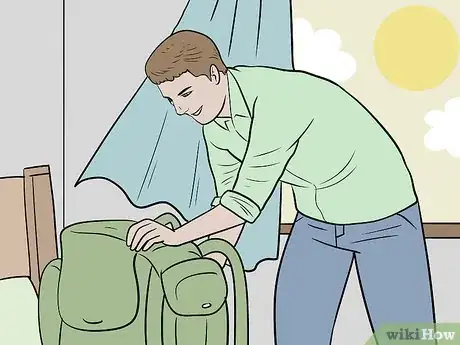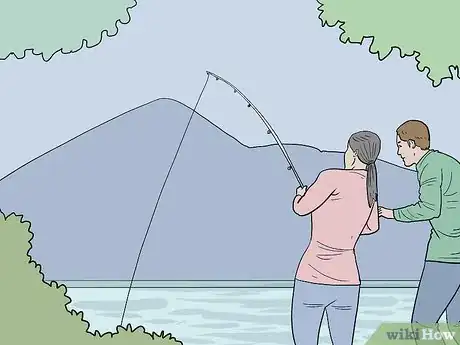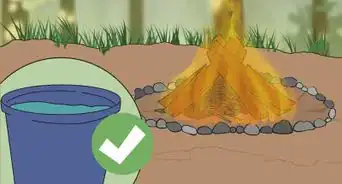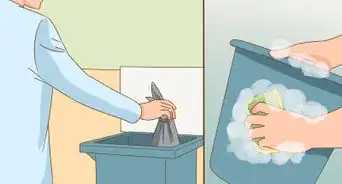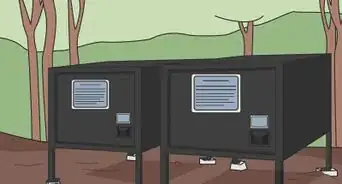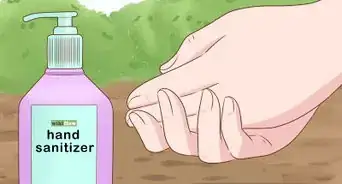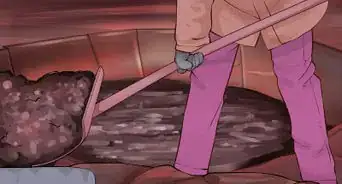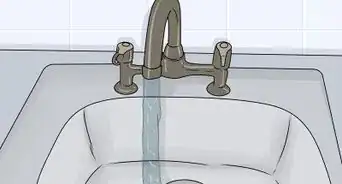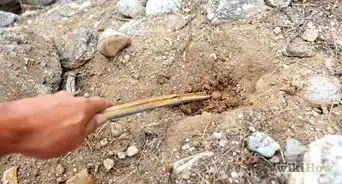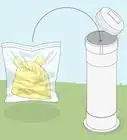This article was co-authored by Britt Edelen and by wikiHow staff writer, Hunter Rising. Britt Edelen was an active member of his local Boy Scouts troop near Athens, Georgia from ages 8 to 16. As a Scout, he went on dozens of camping trips, learned and practiced many wilderness survival skills, and spent countless hours appreciating the great outdoors. In addition, Britt worked as a counselor for several summers at an adventure camp in his hometown, which allowed him to share his passion for and knowledge of the outdoors with others.
There are 7 references cited in this article, which can be found at the bottom of the page.
This article has been viewed 81,381 times.
Everyone needs a break from everyday life, and camping can be a great way to get outdoors and surround yourself with nature. When you start planning your trip, make sure to choose a campsite that fits your needs and pack the materials you need. Once you have your camp set up, you can find nearby activities to explore and have fun while you relax. Even after a short camping trip, you'll feel refreshed and appreciate the great outdoors!
Steps
Packing the Essentials
-
1Bring a tent that’s large enough for you and your things. Find a tent that has about 30 square feet (2.8 m2) per person that’s staying in them. Pick a tent that’s lightweight and easy to transport so you don’t have any hassle setting it up later on. Look at an outdoors store for different types of tents to see how you fit in them and purchase the one that best suits your needs.[1]
- Get a tent with multiple “rooms” if you plan on camping with other people.
- If it’s supposed to rain at all while you’re camping, make sure your tent has a rain cover so you don’t get wet while you’re sleeping.
- Some campsites or outdoors stores may offer tent rentals if you don’t have a tent you can use.
-
2Choose a sleeping bag that matches the climate of the area you’re staying. Sleeping bags have different ratings to determine what temperature they can still keep you warm and comfortable. Check the weather at the campgrounds and determine what the lowest temperatures are so you know which sleeping bag to bring along. If you’re camping in the summer, you can use a thin sleeping bag, but you may need something thicker if you’re camping in cooler months.
- If you don’t want to lie directly on the floor of the tent, consider packing a sleeping pad or an air mattress as well so you have an extra layer of comfort.
- Don’t forget to bring a pillow for yourself so you can stay comfortable.
Advertisement -
3Pack food that’s easy to cook over an open fire. Many times, a campfire is your only heat source while you’re camping, so some foods may not cook as easily as others. Look for foods that you can cook on a skewer, such as hot dogs, cubed vegetables, and meats, since they’re the easiest to hold over a fire. Only bring as much food as you need so you don’t take up too much room while you’re packing.[2]
- Transfer food that’s in large containers into something small and compact so you can transport it easier. For example, you may crack multiple eggs into a plastic bag or container so you don’t break any eggshells while you’re packing.
- You may be able to use a portable grill rack that hangs over the fire to cook larger foods, like burgers and vegetables.
- Bring a cast iron skillet if you have one since you can hold it directly over the fire to cook things like eggs or soups.
Tip: Prep meals at home before you leave so you can reheat or cook them easily once you’re at your campsite.
-
4Use a cooler to help keep food and drinks cold. Pack an insulated cooler with ice and place any food or drinks you want to keep cold while you’re camping. Bring enough water to last through your entire trip so you don’t get dehydrated and so you can stay cool. Store foods in plastic containers and stack them in your cooler so you can use the space efficiently.[3]
- Some campgrounds have ice on site so you can refill the cooler when the old ice melts.
-
5Pack basic survival kits so you can set up your site easily. Basic survival kits include items like pocket knives, flashlights, first aid supplies, and multipurpose tools so you can stay safe while you’re camping. You can either buy prepackaged camping kits or you can make your own and carry it in a toolbox. Make sure you have a kit of materials with you in case there's an emergency or if you need to do maintenance on site.[4]
- Some basic things to include in your kit are knives, bandages, antiseptic wipes, lighters, and emergency flares.
Setting up Your Campsite
-
1Check in with a park ranger or campground office if you need to. Once you arrive at the campground, check in with a park ranger or at the camp offices to confirm your campsite. Let them know you arrived and tell them if you made a reservation before you came. Ask about any special rules or restrictions they have on the grounds so you know what you’re allowed to do. Once they check you in, they will help direct you to your campsite so you can start setting up.[5]
- Look at the office or ranger hours listed when you check in so you know when you’re able to contact them or get supplies if you need them.
-
2Place your tent on flat, dry ground. Once you arrive at your campsite, look for a level place that doesn’t have large rocks or tree roots to set up your tent. Make sure there aren’t any broken or dead tree limbs above the area since they could fall on your tent in severe weather. Clear the ground as much as you can from any sticks or small rocks so you don’t feel them while you’re sleeping. When you pitch your tent, make sure it’s stretched out completely so it’s open to its full size.[6]
- During the Coronavirus (COVID-19) pandemic, make sure to set up your campsite away from other groups so that you don't risk transmission.
- If you can’t find any level ground for your tent, make sure you sleep with your head elevated or else you can get headaches or feel uncomfortable.
- Make sure to always keep your tent zipped so bugs or animals can’t get inside.
-
3Store food in tightly sealed containers so animals don’t get into them. Animals have sensitive noses and they may smell your food while you’re camping. Make sure all of your food is sealed in odor-proof containers while you aren’t cooking to reduce the risk of animals coming onto your site. Place the food about 200 feet (61 m) from your sleeping area so animals don’t interfere with your tent while you’re asleep.[7]
- Animals are usually afraid of humans, so they may not come onto your site while you’re there.
- If you’re in a location that has bears, you can also hang your food from a tree so they cannot access it.
Warning: Don’t keep your food in your tent with you if you’re in an area with bears or large predators since they may be able to smell it and try to get it.[8]
-
4Collect firewood from the campgrounds or nearby sellers. Check for wood around your campsite and collect large pieces to burn during your stay. If there isn’t any wood around you, you may be able to buy some from the campground offices for a small fee. Make sure to get enough firewood for your entire stay so you don’t have to keep buying more.
- Don’t transport foreign wood into the campsite since it could have invasive bugs or bacteria that could infect the local wildlife.
-
5Build a campfire underneath tree cover if possible. Light tree cover helps protect your fire from wind and rain if the weather starts getting worse. Set up your logs inside the fire pit either in a cone or box shape to help maintain a consistent burn. Fill in any gaps with smaller pieces of wood or paper to use as kindling to make starting the fire easier. Light the kindling underneath the logs to start the fire and let it burn.[9]
- Only use a few logs at a time so your fire doesn’t get out of control while it’s burning.
- Make sure you start your fire inside of a pit so it doesn’t spread.
- Put out your fire completely when you’re finished using it so it doesn’t keep burning while it’s unattended.
Planning Your Trip
-
1Look for campsites at national parks to get closer to nature. National parks offer a variety of campsites within the grounds that have different terrain and natural elements around them. Look for a site that has a little bit of tree cover if possible since you can stay protected from the sun or weather. Find a campsite large enough for the number of people you’re camping with so you can accommodate them.[10]
- Basic campsites usually come with a picnic table and a fire pit so you have somewhere to sit and cook.
- Many national park campsites don’t have electricity, so you need to bring extra phone batteries or a portable charger.
-
2Find a campground with electricity if you want to stay connected. Many larger campgrounds have electrical boxes on each site so you can plug in and use anything that needs power. Check if the campsites you’re looking at offer electricity if you still want to use some electronics, such as portable stoves or lights to decorate your site. However, campsites that offer electricity are usually more expensive than those without it.
- Campgrounds with electricity are great if you plan on staying in a trailer or RV since you’ll be able to use your gear inside.
-
3Check if the campground has any facilities or amenities you can use. Campgrounds usually have bathrooms, supply stores, and fun activities that you can do during your stay. Some sites may even have a water supply so you have access to it for cooking and drinking. Check the website for the campgrounds you’re interested in to see what they offer to help determine where you want to stay. [11]
- Campgrounds that have multiple facilities may be more crowded than sites that don’t offer them.
-
4Go camping in spring or autumn for milder conditions. Spring and autumn are usually the beginning and ends of the busiest seasons, so the campgrounds will be less crowded. However, there may be more storms and temperature changes in the spring and fall months, so be sure to pack clothes for different types of weather. Find a week or weekend that fits your schedule and reserve a spot at the campground.[12]
Warning: Campgrounds may close some of their facilities when it’s not peak season. Check with the campgrounds before you make a reservation to see what’s open and closed during your stay.
-
5Camp in the summer for warmer days. Summer is the peak season for camping since the days are warmer and families are able to travel more. If you enjoy spending time outdoors in the sun, pick a time in the summer to take your camping trip. Be sure to make any reservations early since the campgrounds may get crowded and space may run out.[13]
- You may have to deal with thunderstorms or mosquitoes if you camp in the summer.
-
6Reserve a campsite if the campgrounds let you. Check online for the campsite where you want to stay to see if you can reserve a spot. Pick a location on the campgrounds map and the duration that you plan on staying. Once you choose your site, make any down payments for the site if you need to finish your reservation.
- Campsite reservations may cost anywhere between $10-50 per day you’re staying.
- Most campgrounds let you reserve sites a month or two in advance so you can easily plan the rest of your trip.
- You do not need to make a reservation if you don’t want to, but you may risk not getting a campsite if it’s busy.
Finding Fun Activities
-
1Go hiking if you want to explore the area where you’re staying. Check if there are any trails nearby that you can hike along so you can surround yourself with nature. Make sure the trails aren’t too long before you leave, or else you may get too exhausted before you can finish them. When you go out for your hike, put on hiking boots so you can get around easily without hurting yourself. Take snacks and water along with you so you don’t get exhausted or dehydrated while you’re out.[14]
- If you plan on going hiking off of a known trail, then make sure you have a map and a compass so you don’t get lost.
- Don’t litter or leave anything behind on the trails since it could affect local wildlife.
-
2Make s’mores around the campfire for a sweet treat. Break a graham cracker in half and place a piece of chocolate bar on top of one of the pieces. Roast a marshmallow over your campfire until it’s golden brown, or until it feels gooey when you squeeze it. Put the roasted marshmallow on top of the chocolate and set the other half of the graham cracker on top to finish your treat.[15]
- Try using different types of candy when you make your s'mores for different flavors. For example, use a peanut butter cup instead of a chocolate bar for a sweet and salty taste.
-
3Swim in nearby lakes to cool down on a hot day. Check if there are any nearby lakes or beaches that you can go to near your campsite. Make sure they’re open to the public for swimming, or else you may not be able to stay there. Bring a small cooler with you with some food and water so you can enjoy a day on the lake and enjoy time away from your campsite.[16]
- Be sure to wear sunscreen while you’re swimming so you don’t get any sunburn.
- Carefully read any warning signs near the lake or beach if there are any.
- Some campgrounds may have beaches with lifeguards on duty. If there isn’t a lifeguard, make sure you’re a strong swimmer and you stay at a depth where you feel comfortable.
-
4Check what activities are available at the campgrounds. Campgrounds may have special activities or amenities that are available to do during the day. Check if they have any rental equipment, such as fishing rods or kayaks, so you can try new experiences and get away from the campsite. You can also look for games or playgrounds if you want to have fun with the entire family while you’re there.[17]
- Check the map of the campgrounds to see where activities or different sites take place.
- Some campgrounds may have special events around holidays, such as fireworks for Independence Day.
Expert Q&A
Did you know you can get expert answers for this article?
Unlock expert answers by supporting wikiHow
-
QuestionHow do I keep a fire going all night?
 Britt EdelenBritt Edelen was an active member of his local Boy Scouts troop near Athens, Georgia from ages 8 to 16. As a Scout, he went on dozens of camping trips, learned and practiced many wilderness survival skills, and spent countless hours appreciating the great outdoors. In addition, Britt worked as a counselor for several summers at an adventure camp in his hometown, which allowed him to share his passion for and knowledge of the outdoors with others.
Britt EdelenBritt Edelen was an active member of his local Boy Scouts troop near Athens, Georgia from ages 8 to 16. As a Scout, he went on dozens of camping trips, learned and practiced many wilderness survival skills, and spent countless hours appreciating the great outdoors. In addition, Britt worked as a counselor for several summers at an adventure camp in his hometown, which allowed him to share his passion for and knowledge of the outdoors with others.
Outdoor Educator The rule of thumb is that at bare minimum, you need a pile of kindling that's roughly the size of a VW Beetle and then double that. It's a lot of kindling. In a pinch, you can always throw some twigs or pine needles in the fire as it's going out to give yourself a few minutes to go and grab some more kindling.
The rule of thumb is that at bare minimum, you need a pile of kindling that's roughly the size of a VW Beetle and then double that. It's a lot of kindling. In a pinch, you can always throw some twigs or pine needles in the fire as it's going out to give yourself a few minutes to go and grab some more kindling. -
QuestionHow do you put a fire out?
 Britt EdelenBritt Edelen was an active member of his local Boy Scouts troop near Athens, Georgia from ages 8 to 16. As a Scout, he went on dozens of camping trips, learned and practiced many wilderness survival skills, and spent countless hours appreciating the great outdoors. In addition, Britt worked as a counselor for several summers at an adventure camp in his hometown, which allowed him to share his passion for and knowledge of the outdoors with others.
Britt EdelenBritt Edelen was an active member of his local Boy Scouts troop near Athens, Georgia from ages 8 to 16. As a Scout, he went on dozens of camping trips, learned and practiced many wilderness survival skills, and spent countless hours appreciating the great outdoors. In addition, Britt worked as a counselor for several summers at an adventure camp in his hometown, which allowed him to share his passion for and knowledge of the outdoors with others.
Outdoor Educator
-
QuestionWhich camps offer horseback riding?
 Community AnswerThere are hundreds of camps that offer horseback riding! If you want to find one near you, I would search on Google for horseback riding camps in your state. That should give you a full list of options.
Community AnswerThere are hundreds of camps that offer horseback riding! If you want to find one near you, I would search on Google for horseback riding camps in your state. That should give you a full list of options.
Warnings
- Check if the campsite where you’re staying has a problem with bears since you may need to take additional safety measures during your stay.⧼thumbs_response⧽
- Always put out your fires completely at the end of the night so it doesn’t keep burning or get out of control.⧼thumbs_response⧽
- Make sure your campfire is in a contained pit so it doesn’t spread or start a wildfire.⧼thumbs_response⧽
Things You’ll Need
- Tent
- Sleeping bag
- Cooler
- Food
- Water
- Pocket knife
- First aid kit
- Flashlight
- Multipurpose tools
- Lighter
References
- ↑ Britt Edelen. Outdoor Educator. Expert Interview. 7 February 2020.
- ↑ https://cupofjo.com/2015/07/how-to-camp-with-kids-family/
- ↑ https://www.nps.gov/subjects/camping/what-to-bring.htm
- ↑ Britt Edelen. Outdoor Educator. Expert Interview. 7 February 2020.
- ↑ https://www.nps.gov/subjects/camping/finding-and-setting-up-a-campsite.htm
- ↑ https://youtu.be/vfkhlLnSq7o?t=19
- ↑ https://www.nps.gov/subjects/camping/finding-and-setting-up-a-campsite.htm
- ↑ Britt Edelen. Outdoor Educator. Expert Interview. 7 February 2020.
- ↑ https://www.nps.gov/subjects/camping/finding-and-setting-up-a-campsite.htm
- ↑ https://www.nps.gov/subjects/camping/finding-and-setting-up-a-campsite.htm
- ↑ https://www.nps.gov/subjects/camping/when-can-i-camp.htm
- ↑ https://www.nps.gov/subjects/camping/when-can-i-camp.htm
- ↑ https://www.nps.gov/subjects/camping/when-can-i-camp.htm
- ↑ https://rvshare.com/blog/camping-activities/
- ↑ https://rvshare.com/blog/camping-activities/
- ↑ https://rvshare.com/blog/camping-activities/
- ↑ https://rvshare.com/blog/camping-activities/
About This Article
If you’ve never gone camping before, it can feel a little overwhelming to get started. However, if you plan ahead and bring the essential supplies, camping can be a fun and exciting adventure! Before you go, research potential camp sites near you or at your destination to find one that meets your needs. For example, if you’re planning for an extended camping trip, search online for a campground that has supply stores nearby in case you need to restock. You can also look for sites that feature activities you’re interested in, like fishing or hiking. Once you’ve found the perfect camp site, make sure to pack all the supplies you’ll need, such as a tent, sleeping bag, food, survival kit, and clothes that are appropriate for the weather. For tips on how to set up your campsite, read on!
